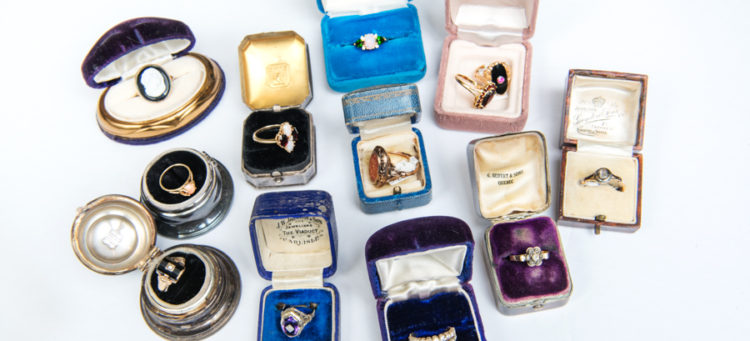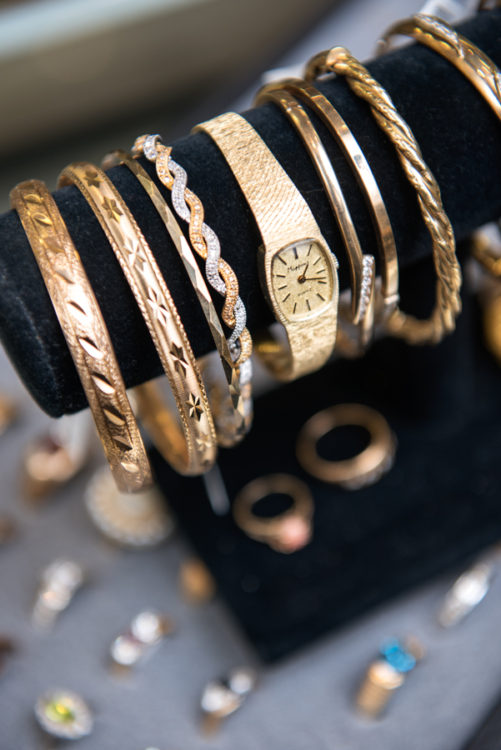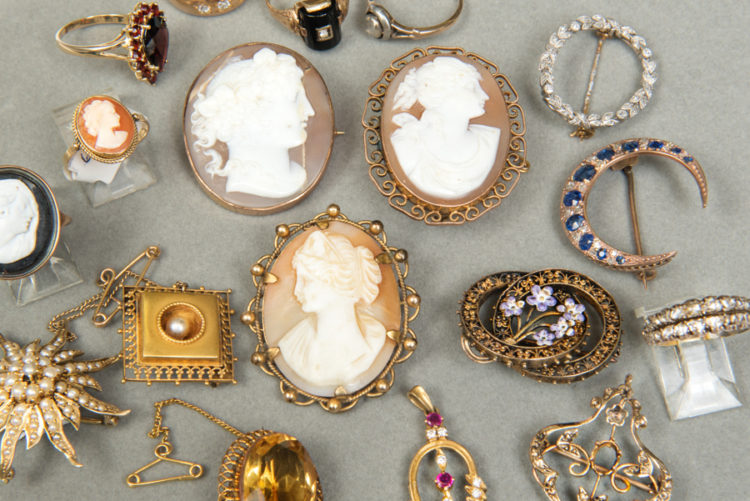
In the Spotlight
Estate Jewellery
April, 2019
An affordable and one-of-a-kind alternative
to buying new.
Believed to carry supernatural powers in Ancient Egypt and used as a symbol of rank in the Middle Ages, jewellery has a history of providing meaning to its wearers. Today, many North Americans turn to jewellery more for self-expression than superstition, and estate jewellery offers them the opportunity to do just that—at a fraction of the cost of buying new.
Estate jewellery refers to anything that has been previously owned, including antique, vintage, and modern pieces. A piece of jewellery has to be at least 100 years old before it can be coined “antique,” and is further categorized by the era it was created in—like Georgian, Victorian, or Edwardian. “Vintage” classification is often applied to pieces starting at 25 or 50 years old, while modern is newer still.

The estate cases at Gemport Jewellery are filled with all three. Joan and Luc Guillemette, owners of the St. Albert shop located at 11 St. Anne St., have been selling estate jewellery for over 30 years, and are experienced stone cutters—a necessary skill set when appraising used jewellery.
Before an item makes it into the estate case, the Guillemettes determine the quality of the stones, the grading of the metals, and whether or not a piece is in need of repairs.
“The more difficult the piece is to reproduce, the more it needs to be ready to wear,” Luc notes.
Antique pieces that are heavily damaged take a lot of time and skill to revive, and depending on their age and condition, may be restored or disassembled and made into something new.
The estate jewellery that remains often contains intricate detail work uncommon in newer pieces, giving buyers a better bang for their buck. Luc notes that in the past 15 years, gold has more than quintupled in price, making it difficult for people to invest in new pieces. Gemport’s estate jewellery offers a more modest price range, starting as low as $100 and going up to several thousand depending on the piece. But the real draw is the craftsmanship.
“We have some pieces that I don’t know anybody who could reproduce them in quality and styling,” he says.
When it comes to shopping for estate jewellery, Guillemette first and foremost recommends picking a piece that you like, and buying from reliable source. “Really, it comes down to trust,” he says.
Reputable jewellers like Gemport require ID and appropriate documentation—like proof of ownership or appraisal papers—from people selling their estate jewellery to ensure the piece is legitimate. This is good news for buyers, who want to be sure they’re getting an authentic piece, and can learn the story behind the jewels before they take them home.
While some scour estate cases looking for something of value, Luc has a different approach: “I never tell people jewellery’s an investment. I tell them that if they want to consider it an investment, it’s an investment in their happiness.”
Shopping for estate jewellery requires walking through each piece’s unique story, and finding one that speaks to you. The pendant you end up with may not denote your rank, but if you’re lucky, it’ll be a unique expression of who you are, with a glimmer of history nestled in its gold filigree. t8n

Antique jewellery 101
When was your antique estate piece was made? You might be able to tell by these features.
Circa 1714-1837: Georgian
Jewellery from this era is rare, as pieces that went out of fashion were often melted down and turned into something new. Topaz, garnet, and emeralds were popular in this period, as was ornate metalwork.
Circa 1840-1901: Victorian
In celebration of Queen Victoria’s marriage to Prince Albert, jewellery in the early part of this age was designed with romantic symbols like hearts and birds. Snakes were also a popular motif—particularly the ouroboros serpent, which symbolizes eternal love.
Circa 1890-1910: Art Nouveau
Meaning “New Art” in French, Art Nouveau jewellery was highly influenced by nature. Colour palettes in this period softened, making use of opals, moonstone and amber, and pieces were known for their elegant lines, as well as animal motifs like bird and dragonflies.
Circa 1901-1915: Edwardian
Edwardian jewellery is characterized by delicate, flowery patterns and lacy filigree. Garland-style bracelets and rings were popular in this time, and featured metalwork in the shapes of leaves and flowers.
Circa 1920-1935: Art Deco
Unlike the sweeping styles of Art Nouveau, jewellery from this period is known by its geometrical or angular patterns. Art Deco pieces favoured large, eye-catching stones over feminine detail.
- art deco
- Art Nouveau
- creative
- edwardian
- estate
- family
- Georgian
- gold
- jewellery
- jewelry
- old
- remake
- rings
- silver
- style
- Victorian













